CONSTELLATION GUIDE
Last updated: 10 August 2001
CONSTELLATION GUIDE |
"GO TO"....CETUS
....look! in the celestial sea! It's a mermaid! No, it's a whale! Well, maybe it's really a SEA MONSTER!
From: sherrodc@ipa.net (Clay Sherrod)
This is the 25th Constellation Guide, "GO TO CETUS" of the series "GO TO GUIDES for the ETX, LX 90 and all GO TO Telescope Users. Cetus is located just below the celestial ECLIPTIC, so the planets, moon, and sun are sometimes nearby, but never within the boundaries of this fairly southern constellation. It is a largely ignored constellation as are many in this area. It IS more sprinkled with brighter stars than other nearby neighbors such as Aquarius, and it contains no less than 27 galaxies bright enough for common telescopes! Indeed, all 27 of these are within the grasp of the LX 90 and larger telescopes; some 20 within reach of the ETX 125, about 14 with the ETX 90 and at least five with the ETX 60 and 70 scopes!
In addition, Cetus holds a WEALTH of multiple stars, the second-most famous variable star, MIRA (second only to ALGOL in Perseus), a fantastic planetary nebula, many star groups and other celestial sights. So how many hours have YOU spent in the large belly of the whale?
Or is it really a "whale?"
In Ethiopian lore, the princess Andromeda was the daughter of Cassiopeia and Cepheus (see http://www.weasner.com/etx/ref_guides/andromeda.html ). Unfortunately her mother was so vain that she thought herself more beautiful than the daughters of Nereus, one of the many gods of the sea. So Cassiopeia was hit by the anger and the revenge of the god Poseidon. To punish the mother, Andromeda was chained to a rock of the coast as a sacrifice for a sea monster, now enshrined as the constellation CETUS (more aptly now configured as a mere "whale!"). Yet she was saved from certain "sea monster death" by the hero, Perseus. After rescuing her he demanded Andromeda as his wife (which the parents gladly accepted, although it was rumored that Perseus was also perhaps "involved" with the wife, Cassiopeia.
It seems that in later lore this "sea monster" has been relegated to a mere Whale of a monster!
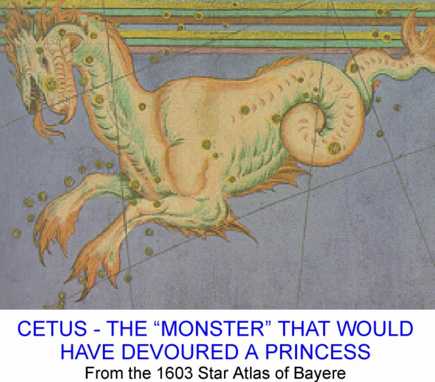
Even with all the galaxies and multiple stars, this is a very minor area of the sky in terms of bright showcase objects, Messier objects (there is only one) and bright stars. However, the constellation makes up in SIZE what it lacks in remarkable objects. So....for the patient observer, spending a little time "going to...." objects in the whale will be VERY rewarding, indeed!
For that reason, I have included a very brief listing of the entire group of 27 galaxies within Cetus that are observable with at least some of our telescopes. There is also an increased number of fine double and multiple stars on our object list for this constellation as well. As a matter of fact, there are so MANY good multiple star here that I highly recommend those interested in the beauty and challenge of these objects to consult with the listing at the beginning of the Cetus chapter in Robert Burnham Jr.'s Celestial Handbook, Volume One. There you will find a concise directory of stars, magnitudes, position angles of major components, separations of the stars and other brief abstracted information.
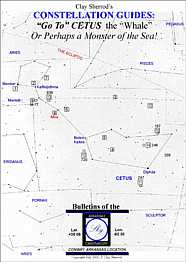
Cetus (pronounced "SEE-tus") is rather uninteresting naked eye constellation of late summer and early fall skies. To most observers who have not spent much time exploring the Whale, it is conceived, incorrectly, that Cetus is located much farther south in the northern hemisphere skies than it actually is. Its highest extent reaches into +10 degrees declination, while the lowest point only sinks to -25 degrees south. Thus, nearly all objects are visible within this large constellation (its breadth extends form 00h to over 03 hours in right ascension - more than 45 degrees of sky east to west!
Cetus rises just south of due east for mid-northern latitudes of about 35 degrees north, its first (westernmost) star Diphda rising about 9 p.m. local time on about September 1. Low to the south, it reaches the meridian, or highest point in the sky, culminating at 2:30 a.m. on the following morning. Midnight culmination - when the center of the large constellation is on the meridian at midnight each year - occurs always on about October 15.
It appears that the great whale is plagued a bit by a pesky "water snake," Eridanus to its south, as the long serpent writhes northward and actually "makes contact" through a mutually share bright star - Pi Ceti - in both drawn outlines of the Whale and the Water Snake!
As with every "GO TO" TOUR guide, each GO TO object in Cetus is discussed for your telescope regarding the type of conditions necessary for you to view it optimally for discern the very faintest details.........magnifications and aperture necessary for most objects, and much, much more. This is YOUR complete GUIDE to get you on your way to exploring the best (and few!) objects in this small constellation. The following listing of "BEST" objects contains the finest or most interesting from my own observing experience and preference.
Use the attached star chart (above) and the following Guide as an excellent reference for your next star party itinerary, or a beginning for further study into the thousands of objects visible in this part of the sky. To access and print the chart, double click on it and save the image to a file on your computer. Once saved, open the file and RESIZE this image to fit the normal paper format for your program and save again....then merely print out the chart on high quality paper for a field reference in this GO TO TOUR!
Truly these extensive Constellation Study Guides will most definitely put your AutoStar to work for you in the most efficient and enjoyable way possible! As a matter of fact, MANY AutoStar users are now programming their own "Tours" based on these guides, using each constellation as a separate GO TO Tour for the AutoStar library that can be added in or deleted through the main edit screen on your PC or MAC computer.
We hope you enjoy these comprehensive GUIDES to touring the constellations via your AutoStar and its computer-driven telescope. Each new installment is complete with diagrams, charts and illustrations that you will find nowhere else. Please let us hear YOUR feedback and your observations of each and every constellation after YOU have toured its vast reaches of our skies!
-----------------------------------
YOUR CETUS CONCISE DIRECTORY OF INTERESTING OBJECTS -
There is a plethora of often-overlooked and very nice deep sky objects in Cetus. In addition, there are some outstanding double and multiple stars as well. For those who think that this part of the sky is void of interesting objects, spend some time here and you will change your mind. The listing which follows is but a sample of the truly remarkable wealth of wonderful objects held within the boundaries of the great Sea Monster. If you enjoy beautiful and challenging double/multiple star observing, there are some wonderful targets for you in Cetus. For a full discussion on double star observing and their "Position Angles" refer to my brief overview in the "GO TO" TOUR guide for Lacerta: http://www.weasner.com/etx/ref_guides/lacerta.html .
I have chosen the most interesting 14 targets in this CETUS "GO TO" TOUR; as with all GUIDES, all objects listed below will be visible in most telescopes (some naked eye) from the ETX 60 through the LX 90; of course larger apertures may "show" an object a bit closer and "better," but frequently a wide field and low power view is more desirable than aperture for FINDING the objects initially. Indeed, I strongly encourage you first FIND the target object, or its approximate location through your GO TO function with your lowest power and then - once IDENTIFIED positively - move up slowly in steps with magnification if necessary. Remember, not all objects "like" magnification. Sometimes better "field of view" (such as the wonderful wide fields provided by the ETX 60 and 70) is desired over light gathering (like the big LX 90) and magnification.
The rule for determining "optimum magnification" is that: 1) too low power results in sky background glow detracting or diminishing the contrast against the deep sky object; 2) too high magnification darkens BOTH the sky background AND the object; 3) medium magnification can be achieved at which you have MAXIMUM contrast between the object and its darkened background sky. I have found through three decades of direct observing that about 15x per inch aperture (36x for the ETX 60/70; 55x for the ETX 90; 75x for the ETX 125; and, 125x for the LX 90).for deep sky observing is PERFECT for most objects. That being said, always remember that DOUBLE or multiple stars require whatever power you can crank out....the seeing conditions are the limiting factor here.
For my complete and comprehensive discussion regarding seeing conditions and sky transparency, see: http://www.weasner.com/etx/buyer-newuser-tips/seeing.html .
With all deep sky objects, avoid attempting to observe when the moon is in the sky, even a very thin crescent, as its brightness in the sky will overshadow the very dim contrast afforded by even the brightest deep sky object; if you see the object at all against moonlight, you will NOT see the subtle outlying areas or the full detail of what is presented.
For detail descriptive lists of the great double stars within Aries, and as with all of the "GO TO" TOUR constellation lists, I recommend a good star atlas and/or chart which will list all the finest objects, constellation-by-constellation. One very handy reference guide is the PETERSON FIELD GUIDE TO THE STARS AND PLANETS, which features complete lists with declinations, right ascensions, magnitudes, and all pertinent information for you to expand your observing horizons beyond this brief GUIDE. For the many double and multiple stars, refer to the indispensable "Burnham's Celestial Handbook", volume 1 for a complete abbreviated listing.
Note that your AutoStar may NOT have every object listed on every constellation GO TO tour....this is intentional. You can access some of the most interesting objects of the sky directly from their coordinates. It is quite simple as you merely enter these coordinates as follows in the 10-step process:
1) Press the "MODE" key and hold down for 3 seconds and release;
2) Displayed will be the current Right Ascension and Declination of the center of field of view of where your telescope is presently pointed (assuming that you have properly aligned from "home position");
3) [NOTE: if you have the Meade electric focuser attached to any of the ETX or LX telescopes, holding down the "MODE" key will bring up the "Focus" command first....merely scroll (lower right scroll key) down one step to access the RA and DEC to enter your desired coordinates]
4) Press the "GO TO" button on AutoStar;
5) This will change the display and you will note the cursor blinking over the first digit of RIGHT ASCENSION (R.A.); merely use the number keys and dial in the R.A. of the object you are searching for;
6) When done, press "Enter;"
7) This moves the blinking cursor over the "DEC" coordinates;
8) [NOTE: the declination, unlike R.A., can be either positive or negative and you will see the "+" or "-" sign displayed depending on where your telescope is aimed at that time; if it is NOT the desired setting (plus or minus), merely use your arrow key to move the blinking cursor OVER the "+" or "-" sign and change by using either of your lower corner SCROLL KEYS;
9) Proceed to enter the DEC using number keys;
10) Press either "Enter" or "Go To" when finished and the telescope begins slewing to your desired object!!
The constellation tour Star Chart above (click on and save to a file on your PC; then open it and re-size to fit the page and print for a very handy at-the-scope star chart) will get you started on your journey for this constellation.
Following is the concise object list for your "GO TO" TOUR of CETUS; you may wish to find many of the objects from the AutoStar Library (for example, you can easily go a fairly bright galaxy, Messier 77, if you pull up "Object/Deep Sky/Messier Object/..then type in '77'...." and then press "Enter", followed by "GO TO" to access this nice spiral galaxy. On the other hand, if you want to experiment and become a "better AutoStar user" try entering the exact R.A. and DEC coordinates of that object as given below after holding down the MODE key. You will find the accuracy of entered GO TO's to be somewhat less than those stored in AutoStar, but the capability of acquiring unlisted objects is fantastic!
You will access your FIRST GOTO target - (usually the brightest star in each constellation) - via the command "SETUP / OBJECT / STAR / NAMED....and scroll to "MENKAR", then press "Enter" and subsequently "GO TO" to move your this bright star.
You may also access the constellation by: SETUP/OBJECT/CONSTELLATION/"Cetus".....Enter....GO TO, which will subsequently take you to the brighter star Menkar, near the northeastern edge of this constellation.
OBJECT 1:
brighter star - MENKAR (alpha Ceti) - R.A. 02h 59' / DEC + 03 54 - Magnitude: 2.5 + bonus double star!
OBJECT 2:
bright double star - KAFFALJIDHMA (gamma Ceti) - R.A. 02h 41' / DEC + 03 02 - Mags: 3.6 & 6.2 nice!
OBJECT 3:
"double" triple - 42 Ceti - R.A. 01h 17' / DEC -00 46 - Mags: 6.4 & 7.3 - 3rd star is too close to see!
OBJECT 4:
nice double! - h2036 - R.A. 01h 18' / DEC -16 04 - Mags: 7 & 7! Nice yellow evenly matched pair!
OBJECT 5:
great ETX 90 test - B399 - R.A. 01h 23' / DEC -11 10 - Mags: 6.5 & 10 - A great double star, 1.6" sep.
OBJECT 6:
nice easy double! - 66 Ceti -R.A. 02h 10' / DEC -02 38 - Mags: 5.7 & 7.7 - wide spacing, great for all!
OBJECT 7:
beautiful double - Nu Ceti - R.A. 02h 33' / DEC + 05 23 - Mags 5 & 9.5 - A real treat!
OBJECT 8:
famous variable - "Mira" (Omicron Ceti) - R.A. 02h 17' / DEC -03 12 - Mag: 2.8 to 9.5 in 331 days!
OBJECT 9:
nice face-on galaxy - Messier 77 (ngc1156) - R.A. 02h 40' / DEC -00 14 - Mag: 8.9, bright and detailed!
OBJECT 10:
very small galaxy - ngc157 - R.A. 00h 32' / DEC -08 40 - Mag: 11, "do-able" with the ETX 90 and up!
OBJECT 11:
huge galaxy, but faint - ngc247 - R.A. 00h 45' / DEC -21 01 - Mag. 9.9 - Very large and spread out.
OBJECT 12:
elliptical galaxy - ngc720 - R.A. 01h 51' / DEC -13 59 - Mag. 10.5 - very small, challenge for 5" scope
OBJECTS 13:
barred spiral and faint spiral - ngc936 & 941 - R.A. 02h 25' / DEC -01 22 - Mags 10.5 & 12.5 - NEAT!
OBJECT 14:
planetary nebula - ngc246 - R.A. 00h 45' / DEC -12 09 - Mag. 8.5, central star is 11.3! Nice object!
*** BONUS: ***
Your Cetus List of OBSERVABLE GALAXIES!! Here is a list of galaxies that might be visible in at least the LX scopes, and most are visible with some difficulty in the ETX 125 as well; this listing is appearing in abbreviated form by 1) ngc number, 2) Right Ascension, 3) Declination and, 4) magnitude (visual) only, then followed by a very brief description and in some cases telescope and observing notes:
151 00 32 / -09 58 / 12.2 - elongated spiral, a target for ETX 125 and larger scopes only 157 00 32 / -08 40 / 11.0 - nice face-on spiral, can be viewed in 3" and larger apertures; brighter center 210 00 38 / -14 09 / 11.6 - larger spiral, somewhat elongated; viewable in 5" but unlikely in 3" scope 247 00 45 / -21 01 / 9.5 - very large spiral (see description below) but very spread out and dim 255 00 45 / -11 45 / 12.4 - small round, very faint star-like spiral, appears nearly stellar in 5" 309 00 54 / -10 13 / 12.5 - VERY faint spiral, visible in LX scope only 337 00 57 / -07 51 / 12.1 - tiny distant spiral, mistaken for a star even in 8" scope 428 01 10 / +00 43 / 11.6 - peculiar spiral, can be spotted in 5", fairly large blur and dim 578 01 28 / -22 56 / 11.2 - oval spiral galaxy, can be barely seen in ETX 90 584 01 29 / -07 07 / 11.2 - VERY tiny elliptical, can easily be mistaken for a star; requires 5" and up 596 01 30 / -07 17 / 11.5 - fairly bright elliptical, good target for 3", very small and star-like 636 01 37 / -07 45 / 12.4 - EXTREMELY tiny elliptical, visible only in 8" scope; starlike and no detail 720 01 51 / -13 59 / 10.5 - another elliptical, but bright enough for the ETX 90 and above, small 779 01 57 / -06 12 / 11.3 - very thin sliver of an edge-on spiral galaxy; glimpse in 3", nice in LX scope 788 01 59 / -07 03 / 12.5 - very small and faint spiral, possible in 5" 864 02 13 / +05 45 / 11.4 - larger spiral can be glimpsed in 3" but fairly nice in 8" scope and larger 895 02 19 / -05 45 / 12.2 - small oval spiral, glimpsed in 5" scope, not much better in LX scope 908 02 21 / -21 27 / 11.1 - fairly large and brighter spiral, easy target in 3" scope and large in 8" 936 02 25 / -01 22 / 10.5 - nice brighter barred spiral, seen in 3" but nice detail in 8" and larger scopes 1022 02 36 / -06 53 / 11.2 - very small but brighter roundish spiral; glimpse in ETX 90 1048 02 38 / -08 45 / 12.4 - larger, but VERY faint, a target probably only for the LX scope 1052 02 39 / -08 28 / 11.2 - tiny elliptical but viewable in the ETX 90; not much different in larger scopes 1055 02 39 / +00 16 / 11.4 - larger, very elongated spiral, nice in 8" scope 1068 02 40 / -00 14 / 8.9 - Messier 77 (see description below) 1073 02 41 / +01 10 / 11.3 - nice round barred spiral; see detail on dark night in 5" and larger scope 1087 02 44 / -00 42 / 11.7 - elongated faint spiral, visible in ETX 125 and larger 1090 02 44 / -00 27 / 12.5 - very faint, visible only in LX scope with difficulty, starlike
---------------------------------
YOUR VISUAL GUIDE TO DEEP SKY OBJECTS IN CETUS
Object 1 - Our "Starting" Bright Star - "MENKAR" (alpha Ceti) **BONUS nearby DOUBLE "triple" star!**
There is a curious arrangement of many 2nd to 3rd magnitude stars spaced evenly throughout our skies that are all in the range of 75 to 175 light years distance, relatively close by cosmic standards. Alpha Ceti, or "Menkar" as it is called is one of them at 150 light years. Menkar in itself is a relatively mundane object, but only 16' due NORTH of this brighter RED star is the 5th magnitude star "93 Ceti" which makes an optical double (not a true "physical" double in that it is bound gravitationally) with Menkar. The star is clearly blue in medium powers (about 70x) and makes a wonderful sight with Alpha Ceti! The blue-red contrast is just remarkable in all scopes, from the ETX 60 to larger LX scopes.
Now....for ETX 90 and larger telescope users, here is a challenge, one that should be easily met with the ETX 125. Look midway between Menkar and 93 Ceti....and just a BIT to the east. Here you will find two very faint (11th magnitude) stars that are separated by about 1.7' arc, pretty wide and easy for all scopes. However, look very closely at the 11th magnitude star that is SOUTHERNMOST and you will see that it, too, is double and much closer! It will appear as two very faint stars, both about the same magnitude; use medium powers (about 50x per inch) to best view these three stars.
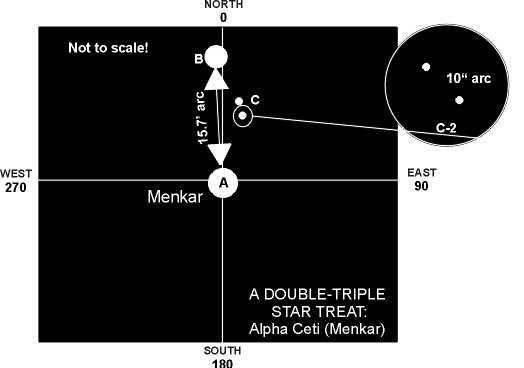
Object 2 - Gamma Ceti - Close and Beautiful Double Star
Here is another one of those "neighborhood stars", some 70 light years away. Gamma Ceti is a gorgeous double star that is easily resolvable in the ETX 90 at high magnification, being separated by about 2.7" arc. The brighter star, brilliant white-yellow, is magnitude 3.6 while the fainter - about northwest (Position Angle 293 degrees) - is 6.2 in brightness. See if you agree that earlier observers noted the brighter star as "yellow" and the fainter a "brownish-blue."
Object 3 - Nice Triple (but you won't see all three!) Star - 42 Ceti
Here is one that provides a good view while allowing your imagination to work a bit for you as well. 42 Ceti is a triple star, two of which are visible in the ETX 90 and larger telescopes. These two stars - magnitudes 6.4 & 7.3 are a tough test (1.6" arc separation) for the 3" scope with about 120x, but should split cleanly. The brighter star should appear very red compared to the more yellowish fainter member. Look for the fainter star almost due north (Position Angle 9 degrees) of the primary star. The fainter star is ALSO a double star, both magnitude 7.5, but is so close (only 0.1" arc) that only the LX 200 16" has a ghost of a chance to show elongation of these two, but even it will not cleanly split the star. Thus, for most of us, we must use our imaginations when viewing this fainter star; if our eyes were big enough they would see a slightly fainter object nearly DUE WEST of the image that you see!
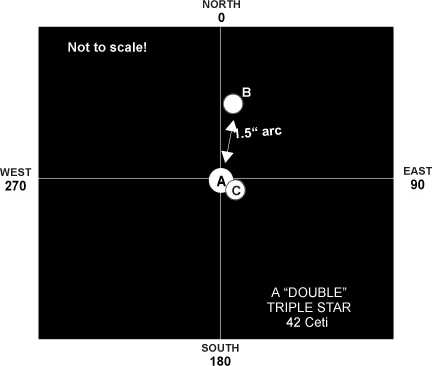
Object 4 - A Very Nice Double Star, and a Great Object for the ETX 90 - "Herschel 2036"
This star is bright enough to easily be seen in the ETX 60 and 70, but the two components are two close to one-another to split it; under very high power (about 125x) with the 70, the star will show elongation however. The two stars are an identical match, both red giants and 7th magnitude. They are arranged in a nearly north-south orientation from one-another, so are easy to sight in on.
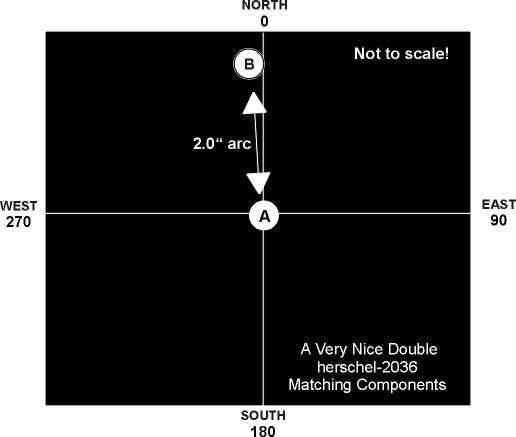
Object 5 - Great Double Star - "Barnard 399" - Not easy, but a great sight in the ETX and larger scopes
This is a pair of stars of much contrasting brightness. The primary is magnitude 6.4 while the fainter companion is 10.3 in Position Angle 302 degrees (about northwest of the brighter star). The separation further challenges users of smaller telescopes, but the ETX 90 "should" be able to make out this faint companion under about 120x. It is quite easy in the ETX 125 and larger scopes and makes for a wonderful sight if you can get the magnification up to around 200x on a very dark night. With this kind of power, you should begin to make out the scarlet red color of both stars, as they are very late spectral type "K" stars. Use the finder chart I have prepared below to help in locating the faint and close companion.
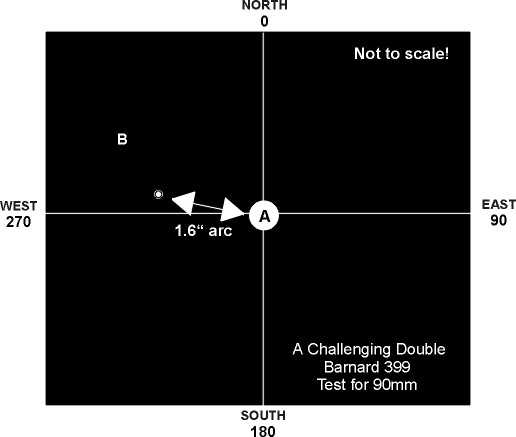
Object 6 - Another Double Star for ALL Scopes! 66 Ceti
Here is a GREAT and easy double star for the ETX 60/70 but also well worthy of observing at low magnifications with the larger scopes as well. The very yellow pair 66 Ceti has a primary star magnitude 6.1 and a companion star about magnitude 7.5 a wide 16" arc southwest.
Object 7 - Another Super Double for ALL....Nu Ceti
No matter what size scope, this is a very nice double star for all. Nu Ceti is quite bright at magnitude 5.2 with a companion star magnitude 9.4 about 8" arc away. Although this will be fairly easy with medium low (about 15x per inch aperture) in the ETX 125 and larger scopes, it is a challenge for the ETX 60/70 due to the faintness of the secondary star, located almost due west of the brighter star. Once Nu is found, up the magnification to about 30x per inch to increase the contrast between the sky and this bright star; the proximity of 5th magnitude Nu will hamper easy acquisition with smaller scopes, but perseverance will prevail!
Object 8 - The Second-most Famous Variable Star of the Sky - Omicron Ceti - "MIRA"
No doubt the most popular of all variable stars is "the Demon Star," ALGOL in the constellation of Perseus in the northwestern sky. See at the same time yearly is another "possessed" star in Cetus, which just so happens to be the second-most famous variable star of the sky! Omicron Ceti, or "MIRA" is also known as "the wonderful" and "the Terrible," depending on which school of philosophy your ancestors belonged to. It is the brightest and most notable of all long-period pulsating red giant stars, or the LPV's (see my complete discussion on variable stars at: http://www.weasner.com/etx/ref_guides/variable_stars.html ). In addition, Mira is one of the most "predictable" of all variable stars, although you will clearly see from the light curve of 3.5 years below that the following attributes DO change from time to time: 1) MAXIMUM - you can see that it sometimes barely exceeds 4th magnitude while at others approaches and even reaches 2nd magnitude; 2) PERIOD - although its "average" span from brightest through dim and back again to brightest (its "cycle") is 331 years, note that it does vary substantially from cycle to cycle; 3) LENGTH OF MINIMUM - you can see that sometimes the "valley" at minimum appears to be cut dramatically short, while at others it seems to drag on for a while....ALSO note that the minimum brightness is nearly always consistent - about magnitude 8.8 average.
Regarding maximum brightness, it is highly unpredictable. In 1779 the star rose to 1st magnitude. Thus, through most of its light cycle, the star can be monitored with the naked eye; with standard 7 x 50 or 10 x 50 binoculars, it can be observed throughout the 331 day cycle. Do not attempt to make estimates (which the AAVSO welcomes, by the way, by send through e-mail to: www.aavso.org ) more often than every two weeks for best accuracy. "Over-observing" tends to introduce spurious light changes that are really not there!
Mira is an ideal star for the ETX 60 and 70 (as well as all other telescopes and binoculars). However, because it is so bright, a very wide field is necessary to obtain comparison stars within the same field of view while estimating brightness. For this, the American Association of Variable Star Observers (AAVSO)provides the naked-eye/ finderscope "a" chart: http://charts.aavso.org/CET/OMI_CET/OMICET-A.GIF while - when the star approaches minimum it is best to "zoom in" on the field with the high magnification "b" chart: http://charts.aavso.org/CET/OMI_CET/OMICET-B.GIF to access stars in the 8th and 9th magnitude range. These charts are available by merely clicking either of the aforementioned URLs, saving the document to file, then resizing and save again. Print out to fit your paper and you have a precise and field tested comparison and finder chart for this star.
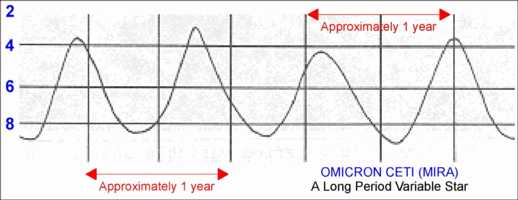
The star Omicron Ceti has so impressed observers throughout the history of mankind that it has been coined "wonderful" and "terrible" by all who have noted its variability. It is indeed, both. Mira - from which all other similar red giant pulsating variables have so been designated as "Mira-type" - is a HUGE red giant that pulsates from internal pressure countered by its enormous gravity....it is this pulsation that results in the visible light changes that we see here from Earth. At about 220 light years away, this huge star is an incredible 400 times the diameter of our own sun!
Object 9 - Messier 77 - A Fine and Bright Face-on Galaxy
This galaxy, although noted now by "Messier 77", was actually discovered in 1780 by Pierre Méchain who said of it: "Cluster of small stars, which contains some nebulosity, in Cetus & on the parallel of the star Delta, reported of the third magnitude, & which M. Messier estimated to be hardly of the fifth. M. Méchain saw this cluster on October 29, 1780 in the form of a nebula."
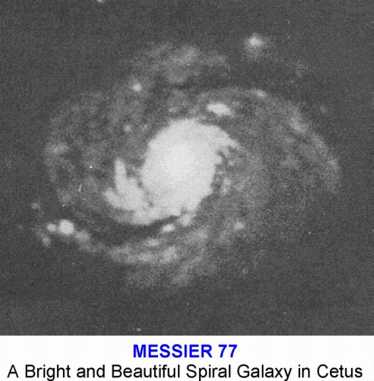
M77 is located only 0.7 degrees ESE from the 4th magnitude star Delta Ceti. The central core of this relatively bright galaxy is about 2 arc minutes and dominates the view of this almost face-on spiral galaxy in the ETX 90 and larger scopes. A great amount of detail is easily visible with higher magnification in larger instruments operating in very dark sky conditions. Be sure to look for the relatively easy NGC 1055 located about 0.5 deg NNW of M77, visible in the ETX 125 and LX scopes as a 3' long edge-on spindle, aligned about east to west, of about mag 10.6. Also note that 11th-mag NGC 1073 is about 1 deg NNE of M77, a face-on galaxy which appears 5' diameter, with a prominent 2x1' bar elongated at about position angle 60 degrees (just north of due east).
With larger telescopes Messier 77 demonstrates a wealth of mottled detail within the limits of the "glow" first seen. During very dark nights and using a magnification of about 140x, the ETX 125 and LX 90 will show considerable irregularity, all of it being the brighter portions of the spiral arms and star conglomerations which can plainly be seen in the 100-inch Mt. Wilson photograph shown above. Note also that the brighter star in seen the lower left portion of galaxy in this photography (actually a foreground object, NOT part of the galaxy) I have seen easily in the LX 90 and larger instruments.
Object 10 - A Faint but Nice Spiral Galaxy - NGC 157
With some discrepancy as to its actual visual magnitude, ngc157 can be seen steadily in the ETX 125 on a very dark night. No detail will be seen in this nor the larger LX 90, but it will appear as a very small and uniform glow about 3' arc across. At magnitude 11.2, it is possible to "barely" see this faint face-on galaxy in the ETX 90 if the skies are very dark. In all scopes use about 40x per inch aperture for best view.
OBJECT 11 - A Fairly Bright and Large Spiral Galaxy - NGC 247
With a visual magnitude given as 8.9, one might think that this very large (as we see it) galaxy might be very easy in even the ETX 60 telescope, but this is not the case. Remember that STELLAR MAGNITUDE is that of a "point source" with the total magnitude compressed into an infinitely small source. Thus a 8th magnitude star is "brighter" visually than an 8th magnitude galaxy, or EXTENDED MAGNITUDE, in which the brightness is "spread out" over the entire surface area. In the case of large ngc247, this means that the 8.9 magnitude is and "integrated magnitude" spread out over an 18.4 x 4.5 minute arc area! Its width is wider than the extent of the full moon! At any rate, this very faint and large object appears as a cloudy "glow" just barely visible in the lowest power you can muster in the ETX 90 on the very darkest of nights. If there is any extraneous light or moonlight, you will totally miss it.....in the LX 90 it requires the widest field and lowest power eyepiece you have. There is no detail visible other than merely a very elongated glow of light, like a tiny lone cloud seen through the eyepiece. All the stars you will see at this low power are stars of our own galaxy - foreground objects.
OBJECT 12 - An Elliptical Galaxy - NGC 720
Here is a modest change of pace, being an elliptical galaxy (one with no spiral structure nor traces of the dark dust and obscuring gases common for spiral galaxies) of magnitude 10.5. It is very tiny, yet CAN be seen in the ETX 60/70 as a very faint and small "fuzzy star." At 2.1' arc, this very distant galaxy gets better with aperture, but - as characteristic with most ellipticals - shows no detail in any telescopes visually and very little photographically even with the world's giant telescopes.
OBJECT 13 - A Barred Spiral - NGC 937 (with notes on NGC 1073)
There are at least two good barred spirals (appear to have a central bar radiating on each side of the nucleus of a galaxy which appears to "connect" bright spiral arms) in Cetus within reach of larger amateur telescopes: ngc1073 (magnitude 11.4, see listing above) and this one, ngc936. At magnitude 10.7 and fairly large (3.3' arc) this one should be visible in the ETX 90, but with no detail. I have distinctly seen both bars in the ETX 125 on a very fine inky-black night with a magnification of about 160x. These bars are distinct, but very faint in the 8" scope. This is a very nice object in really large (16" and above) telescopes. Observers with the ETX 125 and LX scopes should check out both these barred spirals and compare; I have found the bars much easier on the fainter galaxy, almost as though the nucleus is an entire bar itself, with definite hints of two major spiral arms at the end of each!
OBJECT 14 - A Very Fine Planetary Nebula with Central Star - NGC 246
Here is a very small (6' arc diameter) but fairly bright planetary nebula that deserves observing by all amateurs. It CAN be seen in the ETX 60/70, but is very tiny and indistinct and can easily be mistaken for a faint blurry star. However, as seen in the Palomar 200" photograph below, there is a wealth of detail within this interesting shell of gas left enclosing a star which exploded in the prehistoric past.
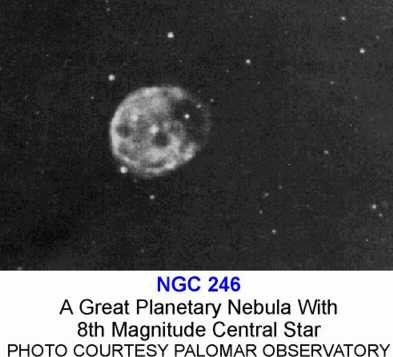
NGC 246 is magnitude 8.5 which is very bright for a deep sky object; dark skies and larger apertures will show a wealth of very elusive and intriguing detail worthy of spending a little time here. The central star can plainly be seen in the ETX 125 and LX 90 at powers of around 150x and above if the sky is dark. The star's magnitude of 11.3 is deceiving, since it can easily be overlooked from the intertwined loops of nebulosity that may obscure it visually. A good test for the limiting magnitude of your telescope is the faint 14th magnitude star seen at the lower right of the planetary nebula, just on its "edge."
----------------------------------
WANDERING ABOUT....YOUR NEW "USER OBJECT" IN CETUS
Rarely do I list a double or multiple star as an "honored candidate" for our USER OBJECT library. Rather, it is normally some freak or conversation object of interest for a star party or public viewing night...something out of the ordinary. However, this Cetus USER OBJECT is merely a double star, an one that is NOT for smaller telescopes. Nonetheless, I challenge ETX 90 users (even 125 users!) to locate the companion to "58 CETI" and subsequently log this into their User Objects on the Autostar to challenge friends and other observers to find both stars!
58 Ceti is a relatively bright (6.9 magnitude) whitish star with a VERY faint 12th magnitude companion just EAST of DUE NORTH of the brighter star. It separation is ONLY 2.0" arc.....so this is most definitely a challenge! Are YOU up to it? Remember, on such stars the brightness of the primary star frequently overshadows attaining a glimpse at the fainter member! See my article discussing such difficulty when attempting to spot the companion star to the brightest star of the sky, Sirius, at: http://www.weasner.com/etx/ref_guides/sirius.html .
On AutoStar, go to: "Select/Object [enter]...." scroll down to "User Object" [ enter]. Now enter the coordinates given above for "runaway", using the number keys on AutoStar. After entering the coordinates and pressing "Enter" yet again, scroll down one and you can list the magnitude of the object as "7"[Enter].
Next Constellation GO TO" TOUR Installment: a questionable Queen of the sky....a concerned mother of a maiden.....a chaired cherub of infidelity.....wife of the wanton child abuser: CASSIOPEIA, whose beautiful (at least she thinks so) face and body have been tethered forever in her throne to encircle the center of the ancient Greek universe, Polaris. This is one of the most remarkable constellations of the sky, both in terms of fantastic objects, and merely by its conspicuous "benchmark" shape. Is it is "W" or is it really and "M?" Well, that depends on whether you observe it in winter or in summer which is possible from high northern latitudes! It also depends perhaps on whether you see that glass of water as "half full"or "half empty."
In either case, we will explore a remarkably "full" "W" of our wonderful nighttime skies. Be sure and focus in and learn more about and within Cepheus' prized queen of the heavens!
Good Observing and may the stars serve as your sentries as you explore the frontiers of space!
P. Clay Sherrod
Arkansas Sky Observatory
Conway / Petit Jean Mountain
Arkansas
Return to the top of this page.
Go back to the Observational Guides & References page.
Go back to my ETX Home Page.